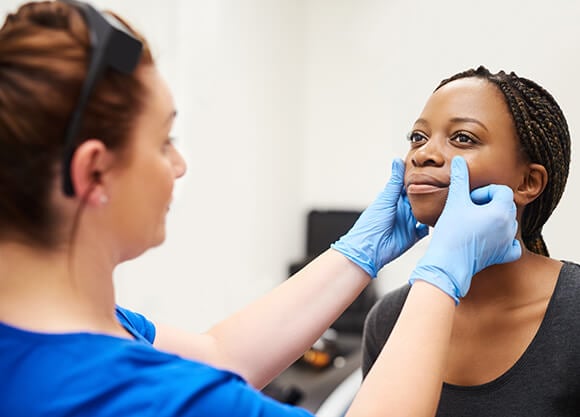
Learning to better care for minority and marginalized populations, skin-first
December 08, 2021

December 08, 2021

A panel of doctors, dermatological experts and medical students unpacked these issues and explored solutions during the annual Dermatology in Education, Research and Medicine (D.E.R.M.) 2021 Conference: Dermatology in Historically Marginalized Populations. The Netter MD School of Medicine hosted the event.
Alaina J. James, MD, Ph.D., is an assistant professor in the Department of Dermatology at the University of Pittsburgh School of Medicine. She discussed how her experience as a dermatologist informed her view of how minorities and other underserved populations weren’t getting the holistic skincare they needed, albeit for a variety of reasons.
This includes lack of transportation, dermatological office deserts and language barriers in educational literature available in-office and on the web.
“I really started to think about the challenging model of getting to an office. This was only part of how we can make health care better,” said James.
To better serve and understand impacted communities, James helped to launch MobileDerm, an initiative that connects doctors with patients in community clinics and health centers. Local community partners include Northside Christian Clinic and the Matilda H. Theiss Health Center, with international satellite sites located in Malawi and elsewhere. MobileDerm also hosts telehealth options.
“Understanding equity means seeing value in our communities and people. When we come across a skin disease or skin problem, address it with the community holistically and see the issues they are dealing with,” said James. “It’s about understanding power, that the option to make decisions for yourself is so important.”
Valuing communities means acknowledging where current practices and learning techniques fall short explained James. She highlighted the idea of visual racism and how internet search engines results are particularly demonstrative of lack of representation.
“Around 80 percent of available images are white-focused. Skin disease can present totally different based on background skin type,” said James. “The message that is sent is impactful psychologically. To see skin like my own, I would have to put in a qualifier.”
For a more equitable representation, skin cancer images should be presented as dark, medium/tan and white with the differences clearly notated, she suggested.
Dermatologist Brett Sloan, M.D., agrees that his field can do better to empower and better serve minority groups, particularly the LGBTQIA+ community. He explained that creating a comfortable environment starts in the waiting room: Gender-neutral bathrooms and open-ended health history questions can encourage a more welcoming space.
“Office staff should be trained to be respectful and avoid assumptions. Patients can be asked politely how they’d like to be addressed,” said Sloan, who is also the editor of the Journal of the American Academy of Dermatology Case Reports.
Once patients are in the office, they are likely to answer inquiries honestly, said Sloan. It is up to the doctor to use culturally sensitive terminology in terms of sexual history, pregnancy planning and other topics in order to ask the right questions, he explained.
“Bias still exists in the medical community and empathetic tendencies can decrease during medical school. Sexual and gender minority terminology is fluid and complex,” said Sloan. “It is our job to do our best to normalize these important questions.”
A holistic understanding of a patient’s lifestyle can be particularly important in diagnosis, said Sloan. For example, sexually transmitted infections like HIV and syphilis often initially present themselves through skin rashes and lesions, he explained.
Roxana Daneshjou, physician scientist and member of the International Skin Imaging Collaboration AI Working Group, spoke about the challenges of machine learning and skincare diagnoses.
Echoing James’ observations, Daneshjou notes the lack of inclusive, clearly labeled images of skin conditions as a barrier to machine learning and accurate AI recognition.
“There is opportunity for bias to enter at all stages of algorithm development. They are based on what’s conveniently available and often leaves out marginalized and underserved populations because of underrepresentation in images,” she said.
Lack of reliable data attached to posted images can be particularly problematic, said Daneshjou.
“Most AI datasets are siloed and not publicly shared due to issues of patient privacy and author privacy settings,” she said. “Data transparency is important and datasets need to clearly be clearly labeled. Good practice requires us to be transparent and share so that people can vet what we’ve done or find issues that may exist.”
This includes creating labels that explicitly detail biopsy-proven results, said Daneshjou.
Practicing dermatologists and researchers can do their part to elevate searchable images by becoming more accurate photographers, said Daneshjou. This means learning best practices for capturing images of darker skin, such as the use of natural light and supplying a neutral, solid background for subjects.
“Clinically, we rely so much on photography to track whether lesions have changed or to send pages to our colleagues. It’s very important to take time to learn about and take good photographs across diverse patient populations,” said Daneshjou.
Quinnipiac Today is your source for what's happening throughout #BobcatNation. Sign up for our weekly email newsletter to be among the first to know about news, events and members of our Bobcat family who are making a positive difference in our world.
Sign Up Now